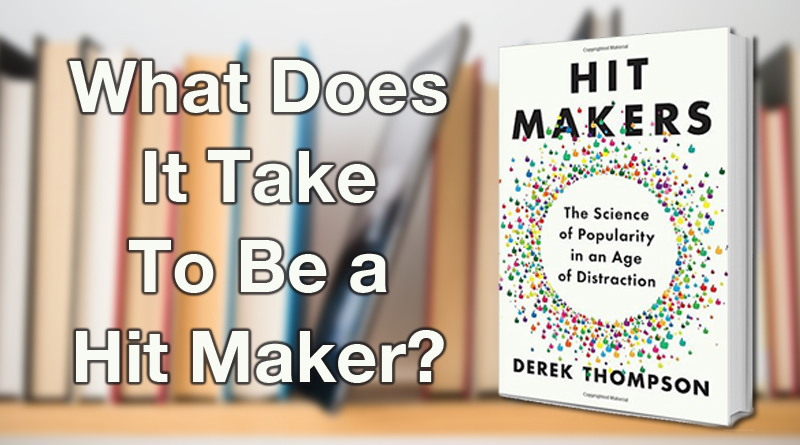Why do some things catch on and saturate culture, while others stay obscure and vanish into thin air? What causes some products to catch the attention of the masses? Whether it’s art, music, television, movies, fashion, newspapers, books, radio, speeches, or social media, a select few rise to the top while the majority sink to the bottom. If we can discover the secret of popularity, we can get our message, product, or brand out to an exponential number of people. That’s the focus of Derek Thompson’s book, Hit Makers, The Science of Popularity in an Age of Distraction. Thompson is the senior editor of The Atlantic and has been named in both Forbes and Inc. magazine’s “30 Under 30” list as well as being called one of Time magazine’s 140 best Twitter feeds worth following.

Thompson leverages the sciences of economics and psychology to shine a light on why people like what they like. The common assumption is that what is most popular has reached that level because of its excellence, but that simply isn’t true. While luck may play a part in why some things rise to fame, it’s really better understood as a combination of distribution, networking, familiarity, timing, and genius. The most valuable currency that we have to offer today is our attention. And capturing that attention is the way politicians, writers, artists, advertisers and app developers have been able to achieve widespread recognition. Thompson starts with Brahm’s Lullaby and Impressionist era art and walks us all the way through to SnapChat and Buzzfeed to give a comprehensive look at popularity.
An Overview
Have you ever wondered why the movies you like have a similar story arch? Or why so many songs you like sound so much like other songs you like? Although it’s not part of the book, an example of this is Bruno Mars and Mark Ronson’s huge hit Uptown Funk which borrowed from a large number of early 80s hits, so much so that they have been forced to expand the list of songwriter credits to include the writers of these earlier hits, and a large number of lawsuits followed. The question is, was familiarity the real reason for the song’s popularity? Yes and no. As Thompson explores why we are drawn to certain products, he explains that when you are developing a new product, people don’t want entirely new things. They want new things that remind them of familiar things. In other words, we should consider whether there is something in this new idea that I can relate to something I already know or like? This design concept is called M.A.Y.A., which stands for Most Advanced Yet Acceptable. Creators should develop works that are a step ahead of everyone else, but not so far ahead that it becomes confusing or worse, distasteful, to the intended audience. Think of Michael J. Fox shredding a Van Halen solo during Johnny B. Goode in the ‘50s.
[bctt tweet=”It is possible to be so cutting edge that no one wants what you are offering.” username=”colephillips”]
When you understand the way people think and the reason why we are drawn to certain things, you are better equipped to develop something that really connects with the culture at large.
The second part of the book dives into popularity and the market. Do you remember the Pokemon Go craze from 2016? That was an example of how “nothing really goes viral,” at least in the way that we think of virality spreading from person to person to person. Instead, for the most part, what seems to go viral is a matter of widespread distribution from the right source to a connected network.
Not long ago, we would play the hits, now due to modern technology, the hits play us back.
Music curators like Shazam, Pandora, Spotify, and Apple Music create specific playlists based on what we already like to introduce us to other songs we will probably like. In fact, video streaming services such as YouTube, Hulu, and Netflix are doing the same thing. How do they know what we will like? They know because we tend to like things that are similar to what we are already familiar with, as well as what others like us are enjoying. Tastemakers know exactly what we are listening to, and for how long. And they are much better at producing exactly what we want to see and hear.
My Recommendation
I always enjoy books like Hit Makers, though there are not enough books as compelling as this one. It is filled with a wide range of fascinating stories from every area of culture. In this way, it is as enjoyable of an experience as Malcolm Gladwell‘s The Tipping Point. Maybe it’s due to my own attention deficit disorder, but Thompson’s storytelling that moves from ESPN, to Facebook, to Disney, and even Star Wars, kept it interesting from start to finish. Thompson details the reasons behind their success and why it matters. It’s also filled with useful principles to help creators understand how to connect with people. With so much competition clamoring for people’s attention in the marketplace of products and ideas, what is the secret of breaking through the static? This book will help you better understand why people are drawn to certain things and uninterested in others.
If you’re looking for a thought-provoking non-fiction book, I highly recommend Hit Makers. If you are a creative, it will not only hold your interest, but it will stimulate your thinking about how you create, and maybe offer you some encouragement as well. At the end of the day, we don’t create simply for popularity’s sake, but it helps to know that you are able to get your work out to the largest number of people possible. Thompson also reminds us that us fast and furious as our world is changing, people are still people with basic desires and needs that change very little, if at all. You can purchase the book on Amazon here: Hit Makers. Also, let me know what you thought of the book. I’d love to hear from you on this topic.
